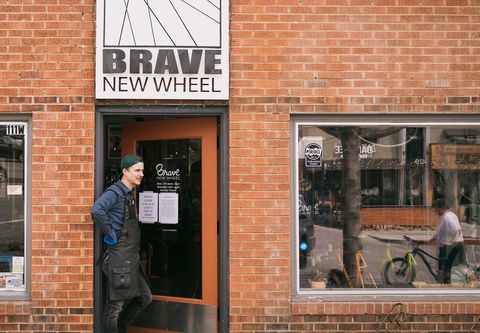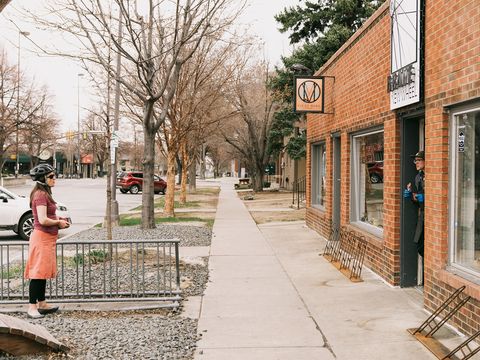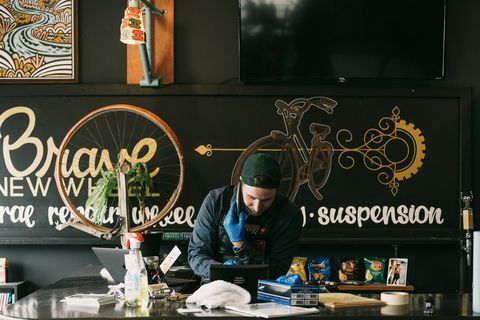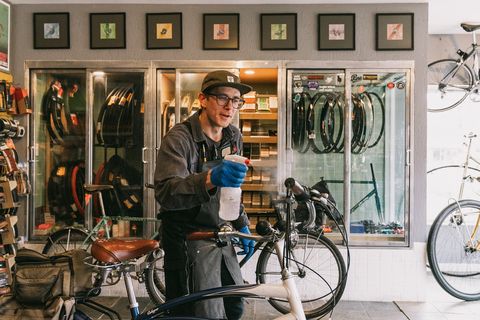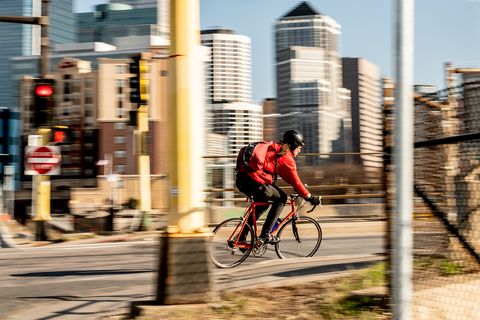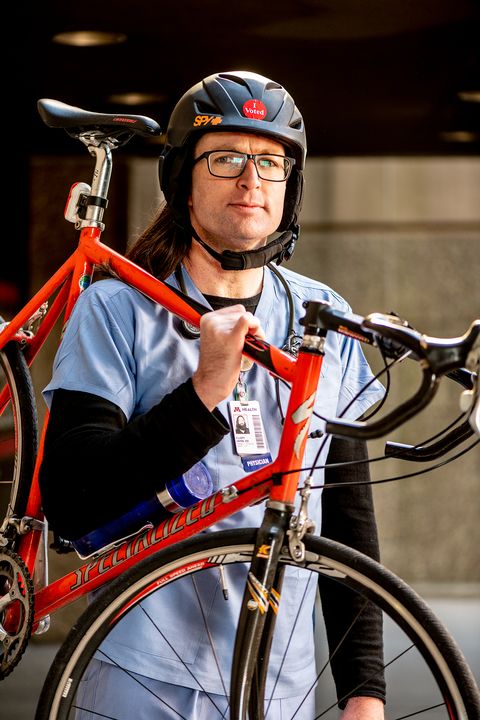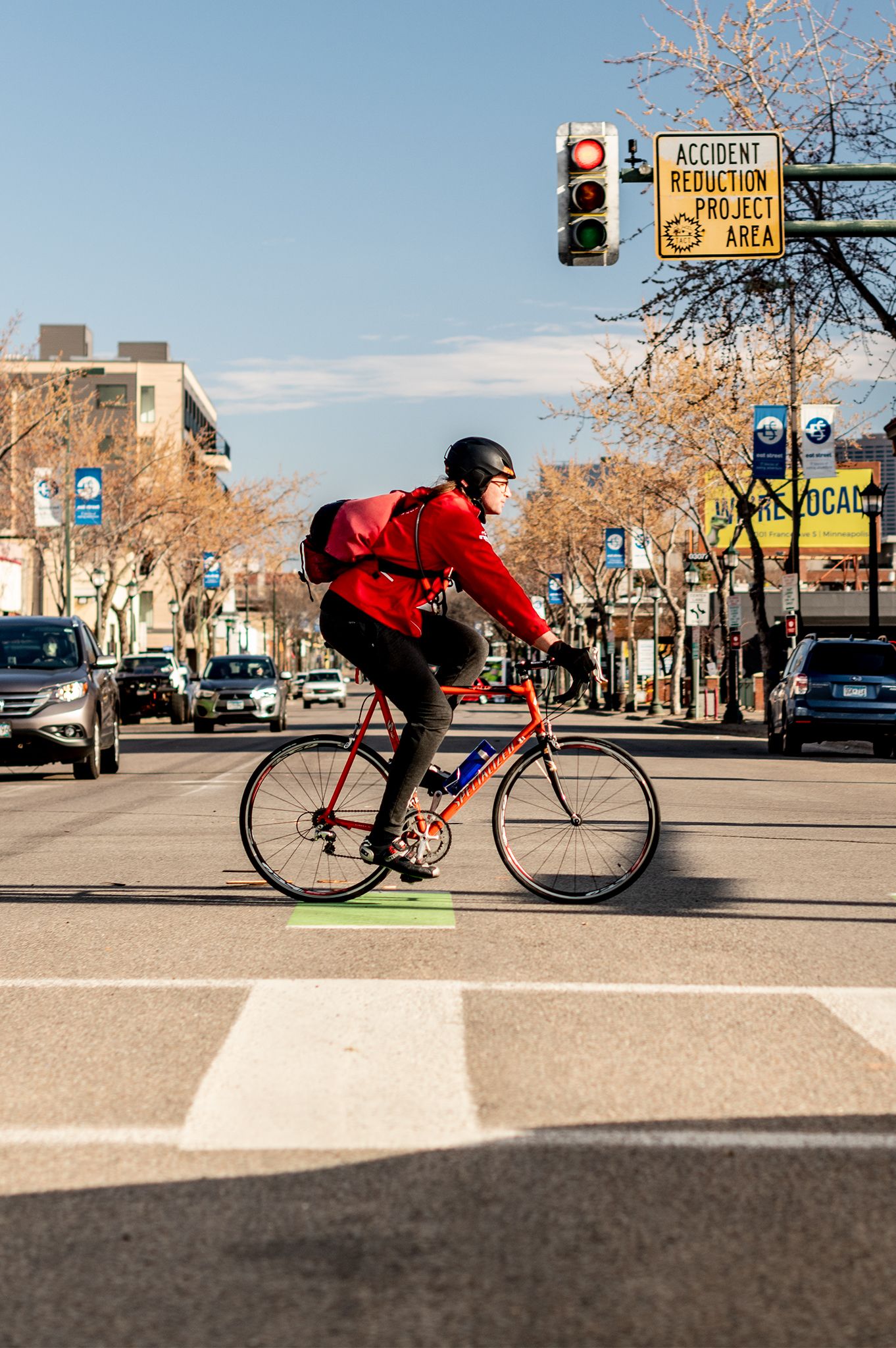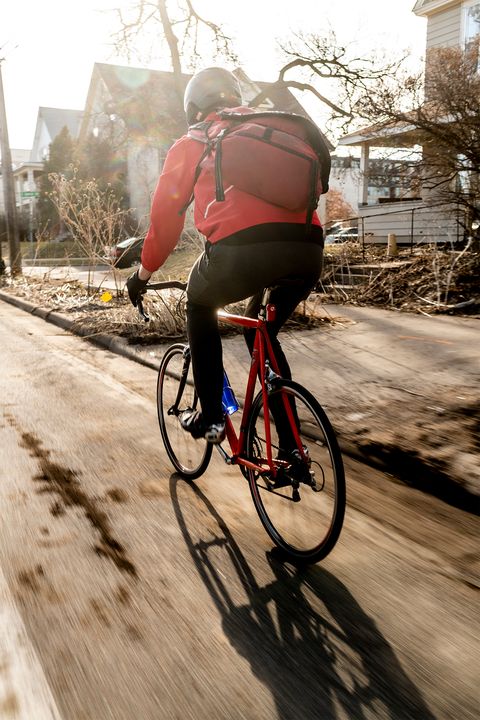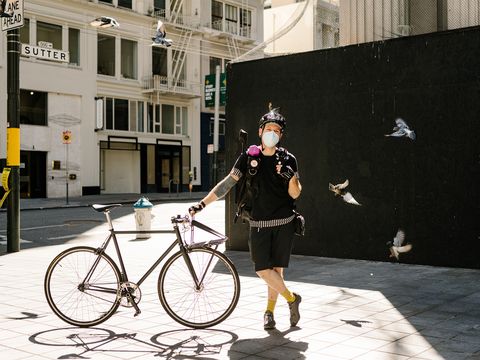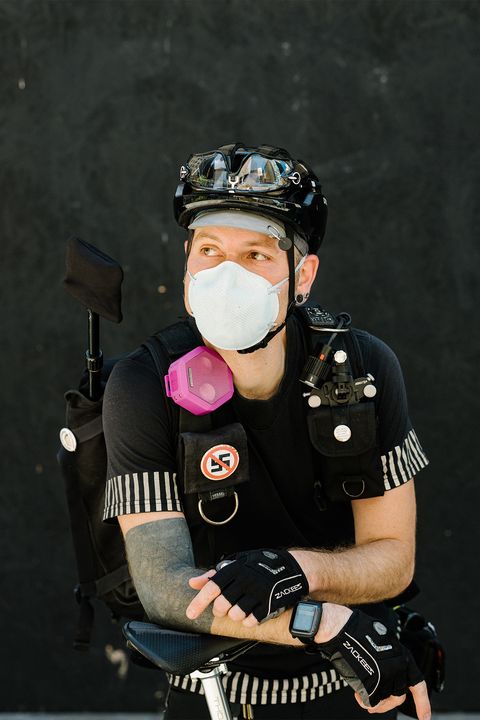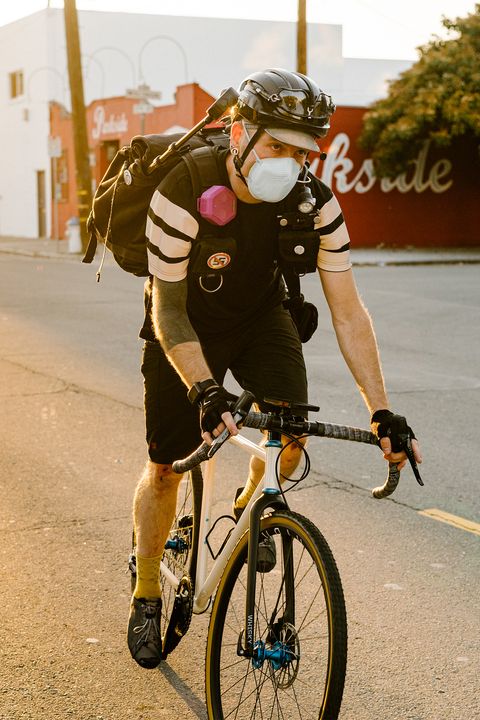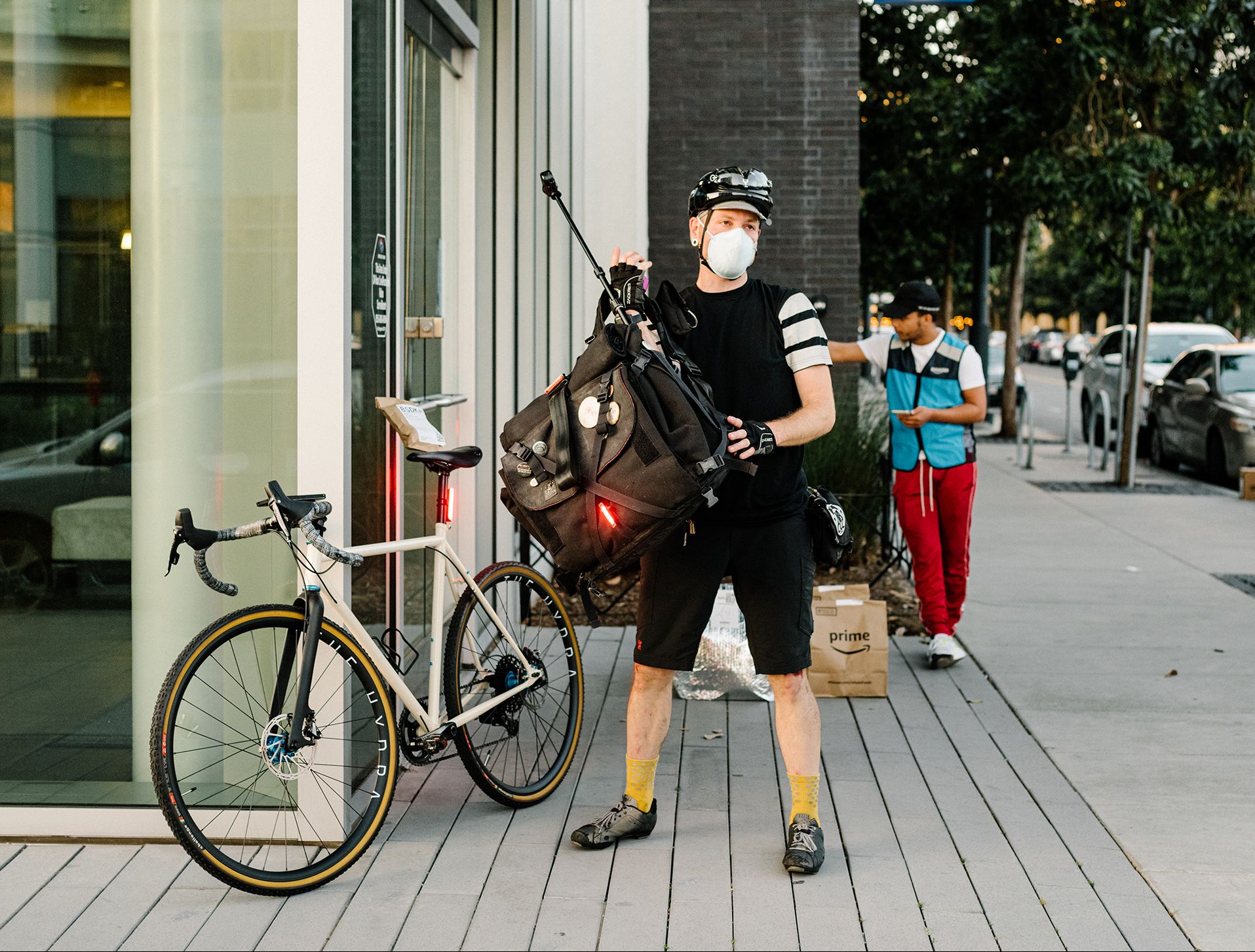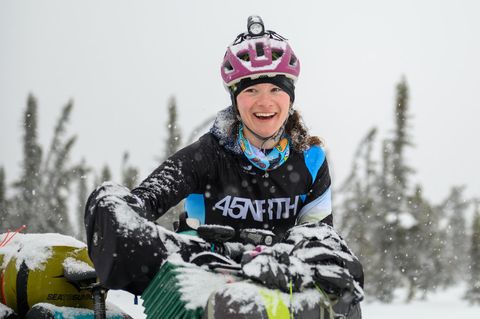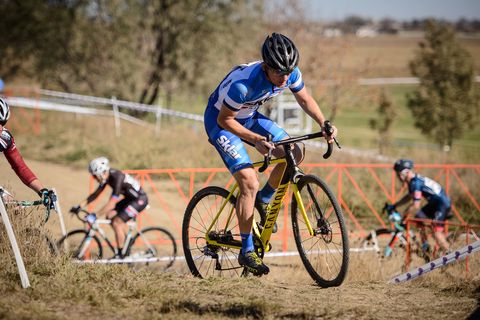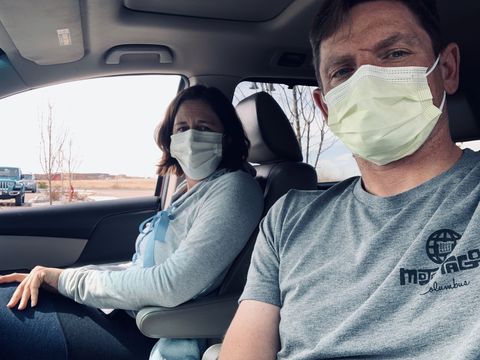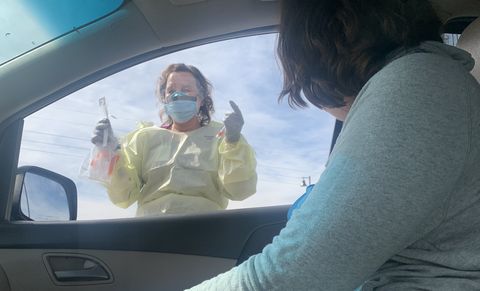First it was a news story about some coronavirus half a world away. Then we learned the new virus was particularly deadly, and it was spreading fast. The new virus crossed the ocean, killed a man in Washington, and then descended on all 50 states. Bike races were canceled. International borders closed. Businesses shut down. And that was just the beginning.
As bad as the COVID-19 pandemic is now, experts are telling us it’s about to get worse. In worst-case projections, 1.7 million people could die in the U.S. alone.
We spoke with five cyclists on the front line of the pandemic: a bike shop owner, a bike-commuting ER doctor, a pharmaceutical bike messenger, an amateur racer infected with coronavirus, and the winner of the Iditarod Trail Invitational (a multi-week, 1,000-mile race that began as coronavirus started to spread in the U.S.). Collectively, they offer a model for how all cyclists can adapt, inspire, and persevere through this unfolding tragedy.
MIKE WOODARD, 39, has been a bike mechanic for more than 20 years, and for the past four, he’s been the co-owner of the Brave New Wheel bike shop in Fort Collins, CO.
For a lot of bike shops around the country, this couldn’t have come at a worse time. We’re seasonal businesses. In spring, summer, and fall, our revenues triple, and we plan our budgets accordingly. And here in Colorado, we’re just coming off a really shit winter. Our mountain-bike trails have basically been closed since Thanksgiving. When you’re just coming out of the slow season, you rely on that springtime jumpstart, and that’s not real promising this year.
We’re right in the heart of Old Town Fort Collins, where the majority of the locally owned small businesses are. At this point, they’re all either shuttered or operating under tight restrictions. When the virus first started to break, we made a rule that only 10 people could be in the store at a time. Then we changed it to five, and finally we decided to lock the doors. On March 20th, we hung a sign on the door that says, “We’re open for repair business, but unfortunately, we have to keep the door locked and not allow customers inside.”
I think people understand. The way we’re doing things now is on an appointment-only basis. We’re asking people to call ahead or email, or even FaceTime—whatever you want. Then we tell people to put their bikes in the rack out front. We’ll come outside to talk to them at a safe distance, and then we disinfect the bike and bring it inside. We’re going through tons of isopropyl alcohol and disinfecting sprays. Every bike that comes inside gets disinfected before anyone touches it, and we have an indoor bike wash that allows us to clean most bikes with soap and water.
We usually operate with three or four mechanics in the store, but we’ve scaled back to two. Fewer people helps us keep a safe distance from each other, most of the time. Every little once in a while, I’m sure we breach that six-foot limit. And we can still get through a decent amount of repairs each day. Not having a constant flow of customers through the store has improved our efficiency.
When we complete a repair job, we try to accept payment over the phone. We’re doing 75 to 80 percent of our sales without any direct contact. We tell customers to call or text when they’re coming by. Then we put the bike outside so they can pull up and grab it. If we have to do an in-person credit-card transaction, we have a Wi-Fi terminal that we carry outside to the customer. People can just stick their card in and pull it out without actually touching it.
I don’t know, maybe everything we’re doing is overkill. Nobody’s ever had to do this before. But we’d rather do too much than not enough. I’d rather apologize to somebody for being too careful than to cause this issue to last any longer than it needs to. At the end of the day, this is still a community that we all have to live in.
Elliott Chinn, DO, 35, is a year-round bike commuter and a first-year emergency room doctor at Hennepin County Medical Center and the University of Minnesota.
Now that the snow’s gone, I’ve switched from my 45-pounds fat bike to the road bike. And with fewer people commuting right now—everybody’s working from home—I’m just flying on my ride into work.
Maybe I was going too fast, but a few days ago, I hit a patch of gravel in a turn and came down hard on my left side. I managed to ride the last two miles in, but my elbow was throbbing. I had one of the attendings put me in a sling, but the pain kept getting worse. Turns out I broke my elbow.
Fortunately, in the rare event I have to do a procedure, I have backup to help me out. Plus, the ER is somewhat quiet at the moment. People are trying to avoid the hospital, so we’re no longer seeing people with benign complaints, like rashes that could be handled at a primary care office. That’s nice, because it lets us focus our time and effort on the potential COVID cases.
We have a few people in the ICU right now, but we’re still looking at this as the calm before the storm. It hasn’t fully hit us here in Minneapolis yet. It’s certainly not like New York. I did my residency in the Bronx, and this morning, I called one of my old co-residents to get a sense of how things are going. He’s admitting five to 15 people a shift for COVID-19 symptoms. That’s just crazy.
We’re anticipating it’s going to blow up here soon. The administration has opened more beds, secured more ventilators, and converted areas for more critical-care access. Every day we see people who could have it. But we don’t have enough tests to know for sure, so right now we’re just testing people who are too sick to return home, plus those who work in healthcare or nursing homes. For everybody else, we send them home to self-quarantine.
We don’t want to discourage anybody from coming to the hospital, of course. But if you show up with a cough and fever, we’re most likely going to discharge you. There’s a good chance you have it, and you risk infecting more people here. If you’re doing all right at home, stay at home. But if you’re having difficulty breathing, or you can’t walk as far as you normally could, you should come in.
We’re good on supplies like gowns and gloves, but probably don’t have enough N95 masks. I’m already reusing mine, which is not ideal. But if we all use a new one with every patient, we’re probably going to run out. So I’ve been putting a surgical mask over my N95, and then tossing the surgical mask after every patient. People have different thoughts on that. Some think you can sterilize it in an oven or with ultraviolet light, but there’s no gold standard yet. There are people who’ve been working here for 30 or 40 years, and they’ve never seen anything like this, so we’re all trying to figure it out as we go along.
Of course, we do know there’s nothing better than washing your hands. So even when I’m wearing the mask, I wash my hands five to 10 times during every patient encounter from putting on and taking off all the gear—face mask, goggles or face shield, gown. Most of the time that’s hand sanitizer, with soap and water once or twice.
A lot of the people I work with are worried because they’re older or they have families at home. One person I work with at the hospital already tested positive. If a nurse or someone in the ER has a fever or cough, they’re not allowed to work until they’ve had a negative test and they’re asymptomatic. I’ve been working extra shifts to help out with people who can’t come in.
I should be back on the bike in a few days. That’s still safe—well, mostly. The only advice I would offer, and this is from personal experiences, is that if you’re biking to work, be very careful. Don’t crash your bike, because you don’t want to end up in the hospital right now.
JOSH*, 38, is a bike messenger in San Francisco. He’s delivered flowers, packages, and food, and currently delivers prescription medication.
When the quarantine went into effect, one of the things that was very clear was that delivery folks would be considered essential. So as a precaution, a lot of the messenger services are now rocking a contactless delivery. My company used to require a signature for some prescriptions, but now when I show up, I scan the package, knock or ring the doorbell, and then stand back to make sure someone retrieves it.
Sometimes a customer will greet me at the door unexpectedly. They still occasionally get a little too close. I have to be like: “Hang on! We’re gonna practice social distancing here! I’m going to literally throw you the package, but I have to scan a couple things in first. So just slow your roll.”
So, yeah. We’ve all been learning to social distance. Some of us are a little bit more advanced. And we’ve had to get creative with how we touch elevator buttons and open doors. Personally, I don’t use my thumb or index finger. I try to use my pinky, or one of the fingers I wouldn’t normally use to touch my face.
You want to be cautious and protect yourself while on the job, but you also want to be cognizant that the best practice is to assume that everyone is infected. And if everybody else is infected—well, maybe you are as well.
For better or worse, I’m already somewhat comfortable wearing an N95 mask. I got my first one in 2018, during the Paradise Fire. That hit the Bay Area really hard and reduced our air quality to shit. Nonetheless, bike messengers were out making deliveries. I own a handful of masks. They’re like gold now, and a lot of people are talking about how to best re-use them. Apparently if you spray them with alcohol, it can degrade the quality. So I set mine on the windowsill. We get a lot of sunlight here, so I leave each mask for a full week with the hope that the sun’s UV rays will disinfect it.
A lot of people are looking at this next month with real uncertainty. How are they gonna feed themselves? How are they going to pay rent? We’re all pretty hand-to-mouth. I feel grateful that I’m still employed and making money, and I feel very supported by the company I work for. But that’s not necessarily the case with all messengers.
The industry standard is to have us employed as independent contractors, and usually, we’re getting paid per delivery. We don’t have protections in terms of PTO, sick leave, or medical benefits. We don’t earn a whole lot in terms of annual income. The job can be rewarding and fun, but you’re also doing it on a knife’s edge. Even beyond any kind of virus or pandemic, this is a dangerous job.
The New York Times just ran an article focused on the risk level for each occupation. Couriers weren’t that far off from nurses and doctors, because we come into contact with so many people and we’re constantly going in and out of buildings. But at the same time, the story also showed that our average yearly earnings are around $29,000.
If I’m feeling sick, I’m definitely not going into work. The last thing I want to do is spread the virus around. But at the same time, I don’t see my ability to opt out as being realistic. This is a job, and I need it to keep a roof over my head.
All that said, people are definitely being nicer these days. When I started in this industry, every time I’d go into a building, it was like, “Use the service elevator, you stinky criminal.” But people are more grateful now. The other day some folks on the street—seemingly houseless folks who would probably never even use a delivery service—were like, “Hey, man! We really appreciate what you’re doing.” That felt good.
*Josh asked that his last name be withheld to protect his job.
JILL MARTINDALE, 32, tied with Casey Fagerquist and Petr Ineman for first place in the 1,000-mile Iditarod Trail Invitational. The race started on March 1, and the trio crossed the finish line after 22 days, 7 hours, and 30 minutes—a span during which COVID-19 spread from 30 cases in the U.S. to more than 30,000.
I reached McGrath about a week into the race. That’s the finish line for the 350-mile racers and a good layover for those of us going on. I already knew the coronavirus was breaking out in China, but I didn’t think I’d be hearing about it during the race. But in McGrath, people were saying the villagers were worried about having outsider visitors. That wasn’t great news considering we’d planned on spending our nights in schoolhouses and with local volunteers.
In Ruby [about halfway], I heard the villages along the coast were shutting down. Then in the next town, Galena, I discovered that Tom Hanks and his wife had the virus. We were all getting these little snippets in each village. Sporting events had shut down. Travel bans were going into effect. Then the schools where we’d planned on staying shut down, and they could no longer provide us with a place to sleep. These little villages don’t have a lot of resources, so if they were to get the virus, it could be horrible.
The trail was so soft that it was hard for anybody to really break away, so Casey, Petr, and I had all been riding on a similar schedule since McGrath. But once we all understood the seriousness of the situation, we started to really stick together. We knew we’d be struggling to find places to stay, and it’s much harder to turn down three people than is to turn down one.
In Nulato, about 750 miles in, the villagers wouldn’t let outsiders enter the town, so that night, we slept in the canvas tent they use to care for sick dogs. There was a wood stove inside, but because the tent was set up on snow, it basically rained on us once we had the fire going. We woke up with wet gear and rode on.
By the time we reached the coast [two days later], we heard the organizers were trying to figure out whether we could go on. We slept in the dining room of a pizza joint that was cranking out pizzas for the dog mushers, but we kept our stay short so they couldn’t pull us from the race.
We all had coughs from being on the trail, so when we were trying to find places to sleep, we had to hold it in while we talked to people. Still, we slept outside a few nights. And things started to look bad in Elim, which is just 200 miles from the finish.
The sea ice was breaking up, and our planned route was disappearing. The organizers pulled everybody behind us from the race—there were nine, I think—and one of the race directors was like, “You guys should call it.” But we were too close.
I’d spent six years planning for this race. I’d put in so much work to qualify and prepare myself mentally and physically. So we spent two nights in Elim while the trail breakers cleared a new overland path, and then we kept going. We figured we’d go as far as we could to give ourselves the best chance of finishing.
Until then, Petr, Casey, and I had been joking about who was going to make a break in the middle of the night to cross the finish line first. But that night over dinner, Petr said, “Alright, how are we going to do this?” After everything we’d been through, we all agreed that it made sense to finish as a team.
In White Mountain we were allowed into the jailhouse long enough to eat and take a nap. Then we slept in a cabin and pushed out early for the last 40 miles to the finish line in Nome.
We crossed after the mushers had already finished. Petr, Casey, and I were the last three participants in the very last sporting event in the world. The finish-line arch had already been packed away, and there were three people there to greet us.
Because we were social distancing, there was no hugging or high-fiving. When one of Casey’s cousins brought us pizza and beer, he just set it down and backed away.
The next day I flew to Anchorage, and that’s where it really started to sink in. It was shocking to see people in face masks. My flight home to Grand Rapids was rescheduled three times, but I finally made it out of Alaska.
I was hoping to have a party to share all the stories, but obviously that’s not happening. And since I’ve been flying, I have to self-quarantine for two weeks. My husband and I have friends who volunteered to leave groceries for us in the driveway. People have shouted “congratulations!” while driving by, and somebody wrote, “Yay Jill! You R Amazing” with chalk in the driveway.
ROB LYDIC, 44, Boulder-based amateur road and cyclocross racer who tested positive for COVID-19.
I received the dreaded call from my local hospital in the afternoon, confirming that my test for COVID-19 administered on March 16 came back positive. It was surreal, but in truth I expected it. I knew that my travels to San Francisco and Los Angeles for work the last week of February may have subjected me to the virus, and as my symptoms began to appear one after another, it had become a higher probability day by day.
My first symptom was a sore throat, which started the first week of March. This is not widely thought of as a symptom, but in my opinion, it was a sign for me.
On March 10, I developed a cough, and I told my family that we would begin to isolate.
This cough was dry and began to really hurt my lungs, which concerned me since I am very dialed in to listening to my body and the strength of my lungs. I began to take vitamin C (Emergen-C), a 12-hour Mucinex, and 1000 mg of Tylenol that day.
It felt like the intersection of my trachea and bronchial tubes were inflamed and under attack. I also began to have body aches that penetrated my back muscles and kidney areas, making them sore. At the same time, my legs and glutes were sore because of a lack of exercise.
I scheduled an appointment with my doctor’s office on March 12, and followed every protocol upon arriving. I remained outside of the office and motioned to the front desk personnel that I needed a mask before entering. I maintained my distance, touched nothing, and stood by a wall waiting to be seen. The nurse practitioner who saw me took my vitals and did not believe that I was subject to COVID-19. My pulse was normal, my temperature was normal, and my blood pressure was normal. She administered a flu test and it came back negative.
On Saturday, March 14 I developed a fever and woke up at 4 a.m. with a sweat that made me believe I had broken the fever. This was the first and only time that I felt that I had a fever.
My wife also began to show symptoms, albeit different than mine. She developed a cough, nasal congestion, an ear infection, and some muscle soreness. My kids, who are 16 and 18, showed no symptoms at all.
We were told to call the Boulder County response line for COVID-19. I shared my new symptoms, and they asked my wife and I to come to an urgent care clinic and to not get out of the car.
When we arrived, the nurse came out to our car wearing a face shield, gown, and mask, and she began to ask us questions and take our vitals. She then said that she would administer the COVID-19 test due to my travel, my symptoms, and my negative flu test.
The nurses told my wife and I that our test results would be available in five to seven days and to call back to get the results then. The state of Colorado was still ramping up efforts to administer and read tests, and the current capacity was 250 tests to be analyzed per day. So began the wait.
That day was one of my worst.
The following day however, things began to change. I woke up on Tuesday feeling a lot better, with my only symptom being sore lungs. My cough had become very intermittent, around once an hour, and my body didn’t ache. I was able to take my dog for a walk in the countryside, and while I was cautiously slow, it was okay and provided some needed relief from the thoughts running through my head.
The next days were interesting though. The aches returned and they ebbed and flowed. The cough stayed at bay with Mucinex, but I had to cycle on and off with the Tylenol. It was truly the craziest feeling that I could feel better and then go back to not feeling great.
I have also discovered that my sense of smell is significantly diminished. This side effect is bizarre as heck.
Emotionally, I am spent by the realities for my family, our community, and the world as a whole.
What does this all mean for us cyclists? In my opinion, it shows that we need to distance—truly distance—from each other and use this time to help society at large. We need to be vigilant about keeping our at-risk populations safe and our families and our fit bodies safe. We need to ride indoors and embrace our trainers.
For those who continue to ride outside, please ride by yourself and note that you need to be ultra-careful while riding, because if you get hurt you may be taking medical resources away from someone who really needs it.
Is it inconvenient? Does it suck? It might, but it sucks a whole lot less than taking a spot away from someone at the hospital, and it sure as hell is better than sharing this terrible virus. We will all get back on the roads and trails again soon and share the joy that is cycling. For now, it may just need to be a little less than we are used to, so that we can recover as a society.
And when this is over, I hope we have the biggest group ride the world has ever seen.
